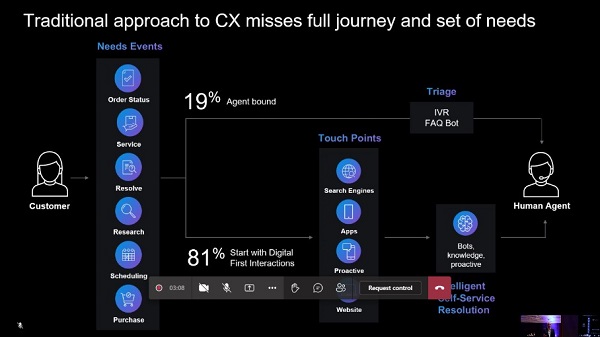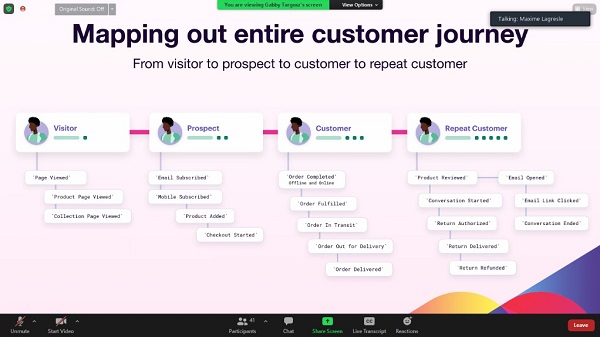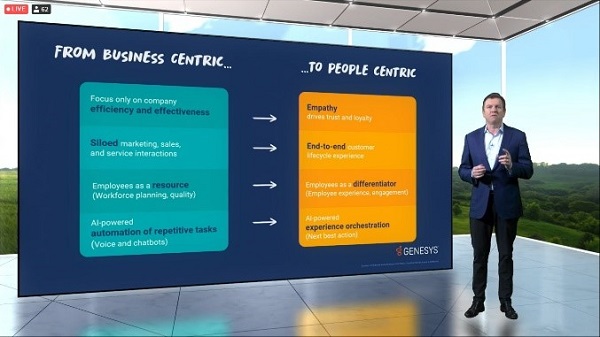Is it over for the contact center? Based on what I’ve seen lately, I think the countdown has begun.
As analysts, we keep busy tracking or attending industry events, especially this time of year. With virtual events being the norm lately, there seem to be two or three every week, and I’ve got some event takeaways here to support my view. Making an observation from one of them about the contact center is just that, an observation, and two is a coincidence. But once you have three similar observations, you’ve got a trend, and that’s what I’m discerning hereafter the NICE, Twilio, and Genesys events.
Don’t get me wrong – the legacy contact center space is alive and well, but it’s struggling to modernize – not only to get on the cloud bandwagon, but to close the gap between current capabilities and today’s customer expectations. There’s still a legacy mindset that views this challenge as needing a technology refresh, much like migrating from legacy PBX to IP telephony.
Like-for-like upgrades will check some boxes, but the root cause issues aren’t being addressed this way. When looking at broader industry trends, there’s a lot of re-imagining going on, and I think these particular players are a pretty good barometer for where things are heading.
NICE: CXi > CCaaS
Impressive and ambitious are two words that come to mind after taking in their recent analyst summit. A bit heavy on the “CX” acronyms, but the strategic messaging is clear. CEO Barak Eilam set the tone in his opening remarks, explaining how NICE can provide Contact Center as a Service (CCaaS) on par with anyone, but they’re aiming much higher.
Just so you can follow along, CXone is their cloud platform, but CXi is the “opportunity,” where customer experience (CX) is much more than agents talking to customers. Whereas most contact centers are just trying to get to first base with some form of cloud migration, NICE has a broader vision – largely driven by AI and analytics – where the contact center has a role but is one piece of something bigger.
If this expansion of customer service sounds like VoIP all over again, you are correct. Legacy telephony lived happily on its own island for decades. But when VoIP came along, it became another data application. From there, we soon got to UC, where all the channels integrate.
As Barak Eilam explained, CXi is about “exceeding the boundary of the contact center” – and just for the record, that means Customer Experience Interactions. The rationale is simple – most “customer need events” don’t originate in the contact center. With so many digital channels now, you need a digital platform to provide a “full CX orchestration” for the entire journey. That’s the essence of CXone, and here’s a screenshot (see image below) to help you visualize all this.
Twilio: Customer Engagement vs. Customer Experience
The next stop on the CX virtual event tour was Twilio Signal. Part of re-imagining CX and the role of the contact center includes looking beyond the usual suspects for solutions. Twilio has tried to break into this space with Flex for a few years now, and it looks like the company is finding its groove. (That’s worth talking about on its own, but let’s keep the focus on the bigger picture view Twilio is taking for this space).
CX has become the raison d’etre for both contact centers and the vendors selling to them lately, and it remains a strong rationale. There’s nothing wrong with staying the course here. But CEO Jeff Lawson is on the same wavelength as NICE’s Barak Eilam—looking ahead to how digital technology and AI are reshaping everything.
When Twilio talks about the customer journey, it’s not just about how they get to the contact center. It’s also about their journey to discover a company, learn about its offerings, shift from prospect to buyer, then begin an ongoing personal relationship that drives trust, loyalty, greater purchasing, and referrals to other would-be customers.
CCaaS as we know it today and contact centers as we know them today each can deliver some of this, but far from the whole sequence. For Twilio, this why their focus is on overall customer engagement (CE), for which the contact center is just one stop along the journey. For those of you driving budgets, remember that the customer experience brings you happiness, but customer engagement brings the money.
Not coming from the contact center space, Twilio has no baggage around this, and the company recognizes how important these outcomes are to a business. That is why they paid top dollar for Segment and SendGrid. There’s a new value chain ecosystem emerging here, where sales, marketing automation, CRM and conventional customer service are becoming interconnected (see image below).
Twilio gets that, but to see it, you have to think of them beyond just being the leading CPaaS player. The market is coming to them to address these emerging needs, and it’s just taken the broader industry a while to catch on. In my view, Twilio is becoming a disruptor, but without being disruptive. The difference is subtle, but I see it as the mark of a leader, not a follower.
Genesys: Business-Centric vs. People-Centric
While all these players have comparable technology capabilities, each is re-framing the problem set contact centers are trying to address in different ways. In my view, all of these approaches are valid, so this must be putting great pressure on contact center leaders to pick a horse to run with. These are not simple decisions about updating core technology, and given how all-encompassing CX is becoming, contact centers leaders will not likely be making them alone.
The stakes are much higher now, and these offerings are going well beyond the contact center as we know it. These new vendor value propositions are about driving top of the line, owning the customer, culture, and embracing AI. This means that CMOs, CROs, and others in charge of business growth will have to participate in a decision-making process that they previously avoided.
Nobody here is talking about legacy KPIs like FCR or AHT, IVR scripts, or call queues. Genesys understands this as well as anyone. Even as a leading pure-play contact center vendor, the company has moved on. They’ll have lots of legacy contact center deployments to support for years to come, but all the R&D, innovation and GTM messaging is focused on today’s challenges.
CEO Tony Bates is a great communicator, and he summed this up nicely during their recent analyst and influencer event. The big shift now is moving from “business-centric” operating models to being “people-centric (see image below).” That certainly aligns with how contact centers need to shift from those legacy KPIs – which revolve around operational efficiency – to metrics that drive CX, which is all about providing personalized service for customers. In Bates’ words, “customers want companies to know them, treat them with empathy – need to know who I am and what I want.”
In broader terms, he talked about how all businesses have to make that shift to succeed in today’s “experience economy.” We know that in our global economy, there’s more competition for everything, and it’s getting harder for companies to differentiate on the goods and services they sell. Differentiation comes more now from experiences, and CX represents the most important intersection between companies and their customers.
To that end, rather than touting CCaaS, Genesys is going to market with experience as a service, i.e., XaaS, using the best of today’s cloud technology and AI for “experience orchestration.” This is the end game for their recent AI-based acquisitions such as Bold 360, Pointillist, and Exceed.ai. Service automation is definitely a focus, and yes, this does speak to the very real need for contact centers to improve self-service and better handle endlessly growing traffic. However, these acquisitions are also under the bigger tent XaaS is addressing, namely digital engagement and sales enablement, as outlined by John Hernandez, executive VP, Genesys.
This isn’t the language contact centers have used much in the past, but it’s central to the conversation today. Genesys, NICE, and Twilio can all provide varying degrees of what contact centers have long been doing, but they’re bringing new narratives that will be hard for the market to ignore. They’re not alone, of course, and I’m just rounding up vendor events here from the past few weeks.
I have no doubt I’ll be hearing more of the same during upcoming events in this space, so don’t just take my word for it. The contact center as we know it is poised to transform from the inside out. This post should serve as a good example of the shape of things to come.
This post is written on behalf of BCStrategies, an industry resource for enterprises, vendors, system integrators, and anyone interested in the growing business communications arena. A supplier of objective information on business communications, BCStrategies is supported by an alliance of leading communication industry advisors, analysts, and consultants who have worked in the various segments of the dynamic business communications market.














